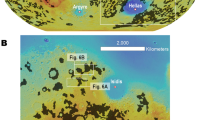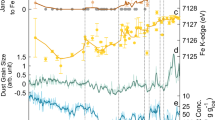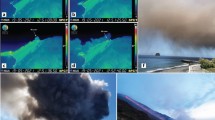Abstract
A longstanding problem of Quaternary geology has been the origin of the silty deposit known as loess. Of the many explanations for its formation and distribution1,2, the most commonly accepted is that the silt is produced by subglacial grinding processes1,3,4, followed by redistribution and deposition by the wind. The large expanses of loess in central Europe are therefore considered to be the consequence of Quaternary glaciation5. There is, however, a view6,7 that loessic silt may also originate as the product of processes in hot deserts. Some proponents of the desert loess hypothesis consider that silt-size material is the product of weathering processes7 which may include salt weathering8 or weathering down incipient cracks9. An alternative mechanism is aeolian attrition of sand grains, although, probably as a result of the experimental work of Kuenen10, Smalley and Krinsley11 consider that only fine silt (2–6 µm) is produced in large quantities by the abrasion of quartz grains. We have simulated aeolian attrition of angular quartz grains previously produced by weathering in deserts. The products of abrasion show that both coarse and fine silt sizes are produced. These findings suggest that desert aeolian processes can produce loess. We also suggest that much of this material from many deserts has been deposited in the sea but that the Chinese loess could have been produced in the Gobi desert. The finest particles produced by such attrition may be a source of silica for silcrete formation.
This is a preview of subscription content, access via your institution
Access options
Subscribe to this journal
Receive 51 print issues and online access
$199.00 per year
only $3.90 per issue
Buy this article
- Purchase on Springer Link
- Instant access to full article PDF
Prices may be subject to local taxes which are calculated during checkout
Similar content being viewed by others
References
Smalley, I. J. Loess: Lithology and Genesis (Dowden Hutchinson and Ross, New York, 1975).
Lill, G. O. & Smalley, I. J. Proc. geol. Ass. 89, 57–65 (1978).
Smalley, I. J. J. sedim. Petrol. 36, 669–676 (1966).
Smalley, I. J. & Vita-Finzi, C. J. sedim. Petrol. 38, 766–774 (1968).
Smalley, I. J. & Leach, J. A. Sedim. Geol. 21, 1–26 (1978).
Yaalon, D. H. & Ganor, E. in SCOPE Rep. 14 (ed. Morales, C.) 187–193 (Wiley, New York, 1977).
Yaalon, D. H. & Dan, J. Z. Geomorph. 20, 91–105 (1974).
Goudie, A. S., Cooke, R. U. & Doornkamp, J. C. J. Arid Envir. 2, 105–112 (1979).
Riezebos, P. A. & Van der Waals, L. Sedim. Geol. 12, 279–285 (1974).
Kuenen, Ph. H. J. Geol. 68, 427–449 (1960).
Smalley, I. J. & Krinsley, D. H. Catena 5, 53–66 (1978).
Linde, K. & Mycielska-Dowagiallo, E. Geogr. Annl. 62 A, 171–184 (1980).
Smith, B. J. & Whalley, W. B. Catena 8, 345–367 (1981).
Folk, R. L. J. sedim. Petrol. 52, 93–101 (1978).
Moss, A. J. J. Geol. Soc. Austr. 13, 97–136 (1966).
Chepil, W. S. Soil Sci. 60, 305–320 (1945).
Smalley, I. J. & Cabrera, J. G. Bull. geol. Soc. Am. 81, 1591–1596 (1970).
Cegla, J., Buckley, T. & Smalley, I. J. Sedimentology 17, 129–134 (1971).
Whalley, W. B. Geol. Mag. 111, 84–86 (1974).
Marshall, J. R., Whalley, W. B. & Krinsley, D. H. Geol. Soc. Am. Abstr. Proc. 1000 (1981).
Whalley, W. B. & Smith, B. J. J. Arid Envir. 4, 21–29 (1981).
Geovanoli, R. Naturwissenschaft 69, 237–239 (1982).
Glaccum, R. A. & Prospero, J. M. Mar. Geol. 37, 295–321 (1980).
Sarnthein, M. & Koopman, B. in Sahara and Surrounding Seas (eds Van Zinderen Bakker Sr, E. M. & Coetzee, J. A.) 239–253 (Balkema, Rotterdam, 1980).
Prospero, J. M., Glaccum, R. A. & Nees, R. T. Nature 289, 570–572 (1981).
Author information
Authors and Affiliations
Rights and permissions
About this article
Cite this article
Whalley, W., Marshall, J. & Smith, B. Origin of desert loess from some experimental observations. Nature 300, 433–435 (1982). https://doi.org/10.1038/300433a0
Received:
Accepted:
Issue Date:
DOI: https://doi.org/10.1038/300433a0
This article is cited by
-
Implications of the discovery of rapidly deposited lacustrine sediments in the Suwalong reach of the upper Jinsha River, SE Tibetan Plateau
Bulletin of Engineering Geology and the Environment (2022)
-
The Medusae Fossae Formation as the single largest source of dust on Mars
Nature Communications (2018)
-
Global cooling and enhanced Eocene Asian mid-latitude interior aridity
Nature Communications (2018)
-
Groundwater characteristics within loessic deposits: the coastal springs of Los Acantilados, Mar del Plata, Argentina
Environmental Earth Sciences (2018)
-
Sand dunes as potential sources of dust in northern China
Science China Earth Sciences (2016)
Comments
By submitting a comment you agree to abide by our Terms and Community Guidelines. If you find something abusive or that does not comply with our terms or guidelines please flag it as inappropriate.



